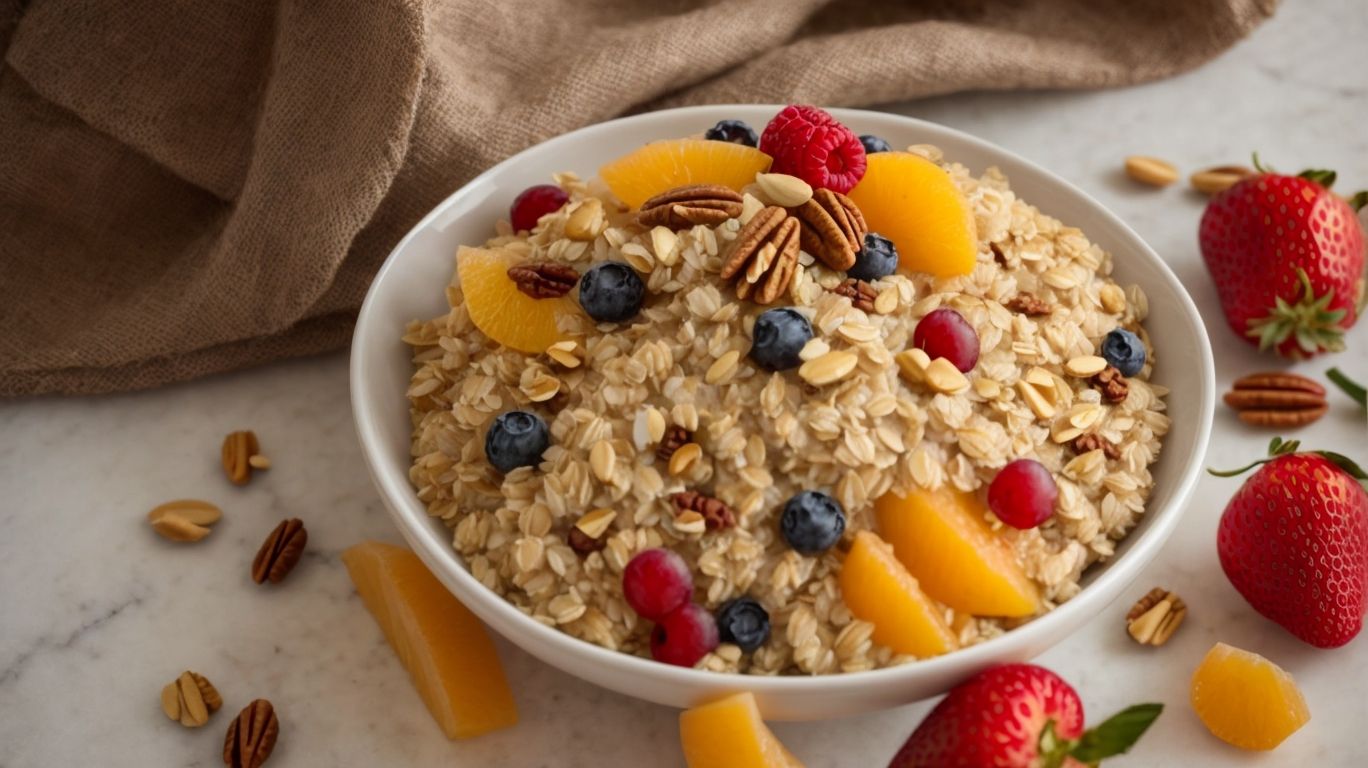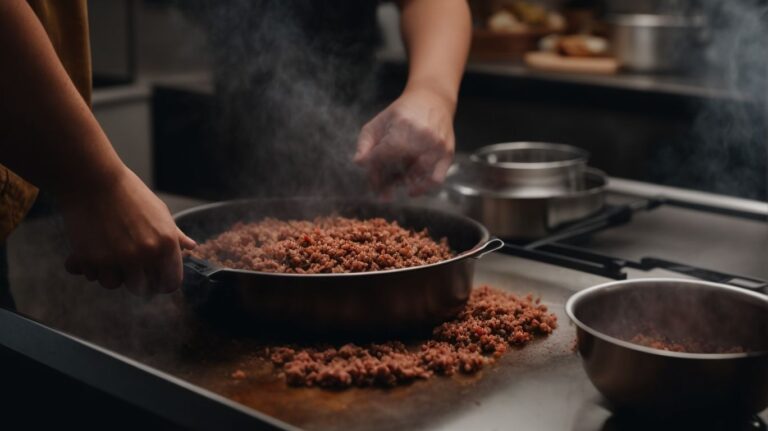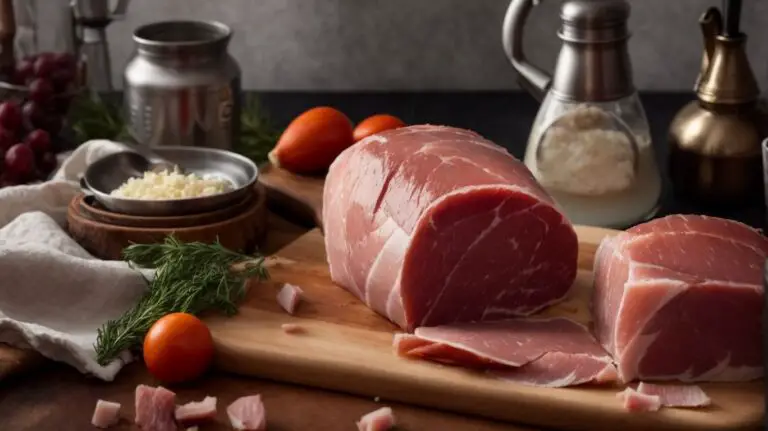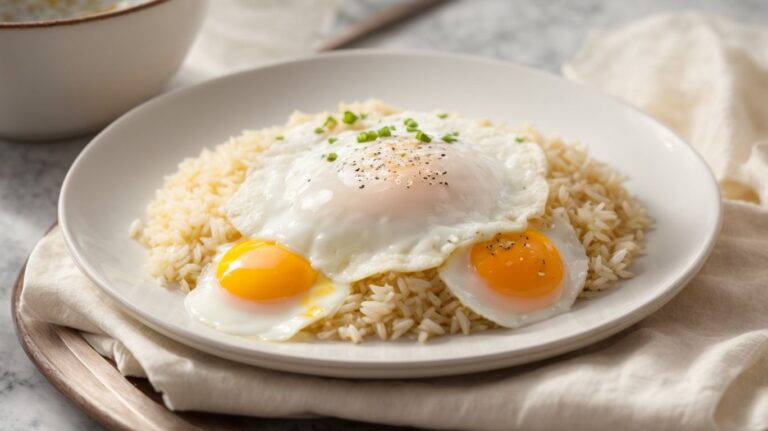How to Cook Oats Without Milk?
Are you looking to switch up your oatmeal routine? Cooking oats without milk can open up a world of possibilities, whether you’re vegan, lactose intolerant, or simply looking for a lower calorie option.
We’ll explore different ways to cook oats without milk, from using water as a substitute to experimenting with non-dairy alternatives and fruit juice.
With tips on adjusting liquid ratios, adding flavor with spices, and topping ideas, you’ll discover the versatility of oats like never before. Join me as we dive into the exciting world of oatmeal without milk!
Key Takeaways:
Why Cook Oats Without Milk?
Discovering why cooking oats without milk can be beneficial is essential for exploring new flavors and health-conscious options.
Cooking oats without milk offers numerous advantages, particularly for individuals following a vegan lifestyle. By omitting milk, this preparation method becomes inherently vegan-friendly, making it inclusive for a broader range of dietary preferences. Avoiding milk can reduce the overall fat content in the dish, promoting a healthier eating choice. To enhance the flavor profile, one can experiment with alternative ingredients like water, various nuts, or a drizzle of olive oil for added richness. Incorporating these substitutions introduces diversity to traditional oatmeal recipes while still maintaining a nutritious and fulfilling meal.
Vegan or Lactose Intolerant
For individuals following a vegan lifestyle or dealing with lactose intolerance, cooking oats without milk provides a nutritious and satisfying breakfast alternative.
These oatmeal recipes can be customized with a variety of plant-based milk alternatives such as almond milk or coconut milk for added creaminess and flavor. Incorporating blueberries not only gives the oats a burst of antioxidant-rich sweetness but also adds a pop of color to your morning bowl. Enhance the nutritional profile by sprinkling nutrient-dense chia seeds on top, providing a boost of fiber, protein, and omega-3 fatty acids. Drizzle a touch of olive oil for a dose of heart-healthy monounsaturated fats that contribute to overall well-being.
Lower Calorie Option
Cooking oats without milk offers a lower-calorie option for those seeking a lighter breakfast choice packed with fiber and essential nutrients.
When you opt for oatmeal recipes without milk, you are not only reducing the calorie content but also boosting the nutritional value of your dish. Oats themselves are a powerhouse of energy, providing sustained fuel throughout the day due to their complex carbohydrates. By adding nuts such as almonds or walnuts, you introduce healthy fats and protein, making your breakfast more satiating. Incorporating fiber-rich additions like chia seeds or flaxseeds enhances the digestive benefits and helps in maintaining a healthy weight.
Different Flavor Profile
Exploring oats cooked without milk introduces a diverse flavor profile, allowing for creative combinations of ingredients such as blueberries, nuts, honey, and maple syrup.
These flavor-enhancing additions bring a delightful contrast of textures and tastes to traditional oatmeal dishes. The freshness of the blueberries adds a burst of sweetness, while the nuts provide a satisfying crunch. Honey and maple syrup offer natural sweetness that pairs perfectly with the hearty oats. By experimenting with different ingredient pairings, you can elevate your oatmeal to a gourmet breakfast experience that is both nutritious and delicious.
How to Cook Oats Without Milk
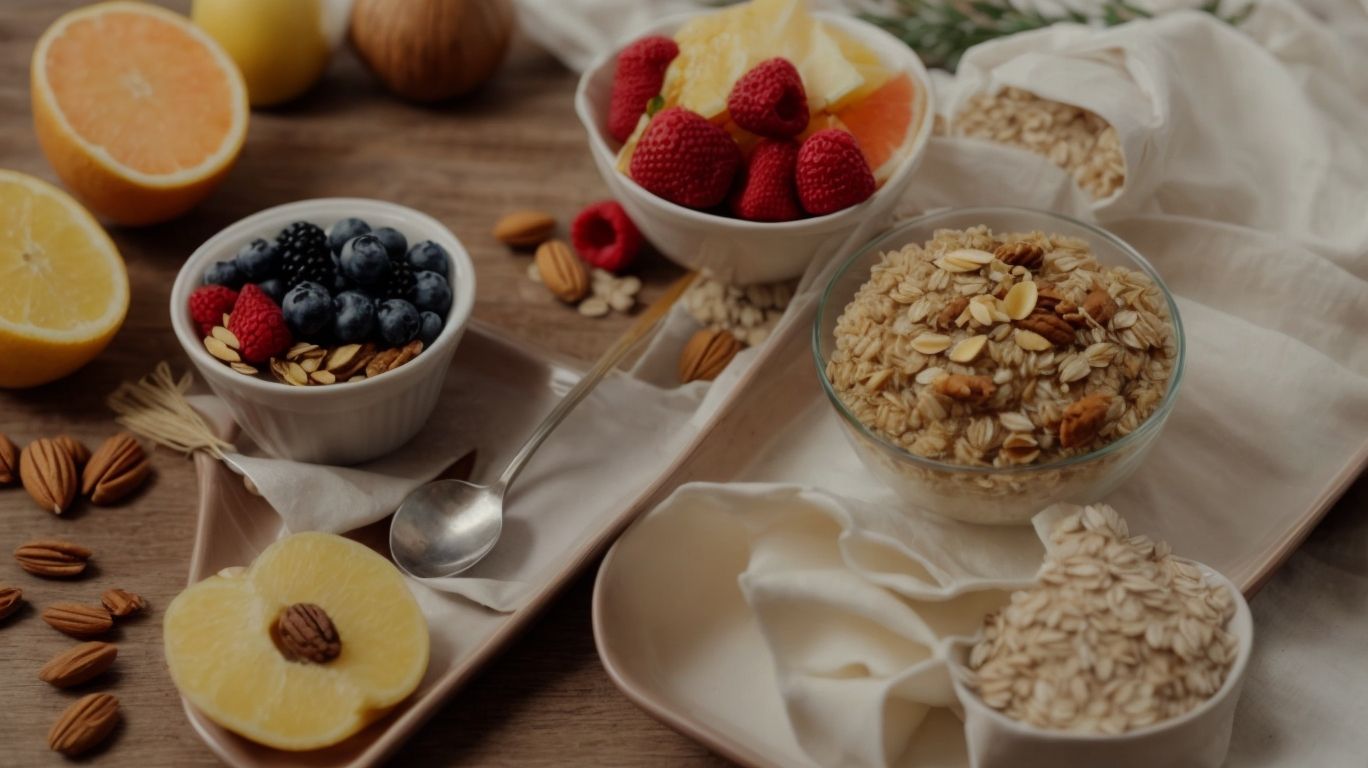
Credits: Poormet.Com – Aaron Johnson
Mastering the art of cooking oats without milk involves using alternative liquids like water, selecting the right ingredients, and experimenting with various flavor combinations.
Start by bringing a pot of water to a simmer, ensuring there’s enough to cover the oats. Add a sprinkle of salt for flavor enhancement.
Next, stir in the rolled oats and let them cook on low heat until they reach your desired consistency. To enhance the nutritional value, consider adding a handful of chopped nuts such as almonds or walnuts for a crunchy texture. Drizzle a splash of olive oil for a dose of healthy fats and richness to the dish.
Using Water as a Substitute
Utilizing water as a substitute for milk in oatmeal recipes offers a simple and vegan-friendly option that still provides essential nutrients and a creamy texture.
When preparing oatmeal with water, simply use an equal amount of water as you would with milk and cook it according to your usual oatmeal recipe. This small adjustment not only caters to those following a vegan diet but also reduces the calorie content typically found in dairy milk. With water, you eliminate the saturated fats often present in cow’s milk, making your breakfast a healthier choice. Water is a universal ingredient, making it easily accessible and cost-effective compared to specialty plant milk alternatives.
Using Non-Dairy Milk Alternatives
Incorporating non-dairy milk alternatives like coconut yogurt, nut butter, or tahini can elevate the flavor profile of oats cooked without milk, catering to vegan and plant-based preferences.
Coconut yogurt, with its creamy and slightly tangy taste, brings a richness to the oatmeal while also providing probiotics for gut health.
Nut butter, whether it be almond, peanut, or cashew, adds a delightful nuttiness and boosts the protein content of the breakfast.
On the other hand, tahini introduces a unique sesame flavor that lends a savory dimension to the oats. These alternatives not only enhance the taste but also make the recipe suitable for individuals with lactose intolerance or those looking to explore diverse plant-based options.
Using Fruit Juice
Infusing oats with fruit juice offers a refreshing twist to traditional oatmeal recipes, enhancing the breakfast dish with natural sweetness and vibrant flavors from fresh fruit and berries.
Adding a splash of fresh fruit juice like orange juice or apple juice to your oatmeal not only imparts a delightful fruity essence but also boosts the nutritional value of the meal.
Imagine a bowl of creamy oatmeal topped with a medley of fresh berries such as strawberries, blueberries, or raspberries, creating a colorful and nutritious breakfast treat.
These additions not only provide a burst of flavor but also contribute essential vitamins, antioxidants, and fiber to your morning meal.
By experimenting with different fruit combinations and toppings, you can tailor your oatmeal to suit your taste preferences and dietary needs.
Using Broth or Stock
Experimenting with savory oats using broth or stock, along with aromatic ingredients like garlic, onions, and turmeric powder, can transform traditional oatmeal recipes into hearty and flavorful meals.
Such savory creations provide a harmonious blend of creamy oats and rich umami flavors, offering a delightful alternative to sweet breakfast options. Incorporating broth or stock infuses depth and complexity into the dish, creating a comforting base for further customization. The addition of garlic adds a savory kick, while onions bring a subtle sweetness to balance the flavors. Turmeric powder not only imparts a golden hue but also offers a hint of earthiness and health benefits.
Tips for Cooking Oats Without Milk
Enhance your oatmeal cooking skills by adjusting the liquid to oat ratio, experimenting with spices and seasonings, and incorporating nutritious toppings for a wholesome and flavorful breakfast experience.
One key tip for cooking oats without milk is to substitute water with a plant-based milk alternative, like almond milk, for a creamier texture and added flavor. You can enhance the nutritional value of your oatmeal by adding chia seeds and flax seeds for a boost of omega-3 fatty acids and fiber. Experiment with different combinations of spices such as cinnamon, nutmeg, or vanilla extract to tailor the flavor profile to your liking. Remember to stir occasionally while cooking to prevent sticking and achieve a smooth consistency.
Adjusting Liquid to Oat Ratio
Achieving the perfect oatmeal consistency starts with mastering the liquid to oat ratio, ensuring a balanced and creamy texture in your oat-based creations.
Regarding adjusting the liquid to oat ratio, it’s essential to strike a perfect balance between too dry and too watery. This delicate equilibrium is what elevates a simple bowl of oats to a delectable, satisfying meal. Incorporating healthy ingredients like chia seeds not only adds a boost of nutrients but also enhances the creaminess of your oatmeal. The addition of fiber-rich elements such as flaxseeds or nuts can further elevate the texture and nutritional profile of your morning staple. Experimenting with different ratios and ingredients can help you discover your ideal oatmeal texture that suits your preferences and dietary needs.
Adding Flavor with Spices and Seasonings
Elevate the taste profile of oats cooked without milk by incorporating a blend of aromatic spices and seasonings such as garlic, turmeric powder, cumin powder, and garam masala for a burst of flavor.
Transform your plain oatmeal into a tantalizing dish by sautéing minced garlic in a drizzle of olive oil until fragrant, then sprinkle a pinch of turmeric powder for a warm, earthy undertone.
- Add a generous dash of cumin powder for a subtle nutty flavor, and finish with a sprinkle of garam masala, a fragrant blend of ground spices that will enhance the overall taste experience.
Topping Ideas for Oats Cooked Without Milk
Delight your taste buds with a variety of topping ideas for oats cooked without milk, including hemp seeds, chia seeds, nut butter, and a dash of vanilla extract to create a nutritious and flavorful breakfast masterpiece.
For a tropical twist, sprinkle some toasted coconut flakes on top of your oatmeal along with a drizzle of honey for added sweetness. Another delicious option is to stir in fresh berries like blueberries or strawberries for a burst of fruity flavor and an antioxidant boost. Consider adding a spoonful of almond butter or cashew butter for a creamy texture and extra plant-based protein.
Conclusion
Experimenting with different substitutes for milk in oatmeal recipes opens up a world of culinary possibilities, allowing you to enjoy the versatility of oats while exploring various flavors and textures.
One popular alternative to dairy milk in oatmeal is almond milk, which adds a subtle nuttiness and creaminess to your morning bowl.
For those following a vegan diet, coconut milk can provide a rich and indulgent option, perfect for a decadent treat.
Moreover, soy milk is known for its protein content, making it a nutritious addition to your oatmeal.
You can even experiment with oat milk itself, elevating the oat flavor and creating a harmonious blend.
By embracing these alternatives, you can cater to different dietary preferences and unleash your creativity in the kitchen.
Experiment with Different Substitutes
Embark on a culinary adventure by experimenting with various substitutes for milk in oatmeal recipes, discovering new flavor combinations and nutritional benefits that cater to your preferences and dietary needs.
One interesting alternative to traditional milk in oatmeal is almond milk, which adds a subtle nutty flavor and a creamy texture.
For a tropical twist, coconut milk can bring richness and a hint of sweetness to your morning bowl.
Soy milk offers a plant-based protein boost, while Oat milk complements the oatmeal base perfectly, enhancing the overall creaminess.
Cashew milk, with its velvety consistency, can add a luxurious touch, especially when paired with some maple syrup and cinnamon.
Enjoy the Versatility of Oats
Embrace the versatility of oats in your culinary creations, from savory to sweet, by incorporating a range of toppings like coconut yogurt, hemp seeds, and other nutritious ingredients for a delightful and wholesome dining experience.
Oats serve as a canvas for your culinary adventures, ready to take on the flavors of your choosing. Whether you prefer a cozy bowl of cinnamon-spiced oats during breakfast or a hearty savory oatmeal topped with sautéed mushrooms and a sprinkle of nutritional yeast for lunch, oats can cater to your taste buds effortlessly.
- Experiment with different textures by adding crunchy nuts or creamy nut butter to your oats, creating a harmonious blend of flavors and mouthfeel.
- For a refreshing twist, try mixing in fresh fruits like berries or sliced bananas, adding a burst of natural sweetness to your oatmeal.
- Don’t forget the power of spices such as cinnamon, nutmeg, or even turmeric, to elevate the complexity of your oatmeal and introduce exciting new flavor dimensions.
Frequently Asked Questions
How to Cook Oats Without Milk?
Oats are a nutritious and versatile breakfast option, but what if you don’t have any milk on hand? Here are some FAQs on how to cook oats without milk:
Can I make oatmeal without milk?
Yes, absolutely! You can make oatmeal without milk by using a variety of dairy-free options such as water, non-dairy milk alternatives, or even juice.
What can I use instead of milk in oatmeal?
If you don’t have milk, you can use water to cook your oats. For a creamier texture, you can also use non-dairy milk alternatives like almond milk, coconut milk, or oat milk.
How do I make oatmeal with water?
To make oatmeal with water, simply combine water and oats in a pot and bring to a boil. Reduce heat and let it simmer for 5-10 minutes until the oats are cooked to your desired consistency.
Can I use juice to cook oatmeal?
Yes, you can use juice to cook oatmeal for a different flavor profile. Just be mindful of the sugar content in the juice and adjust accordingly.
What are some healthy toppings for oatmeal without milk?
You can top your oatmeal with a variety of healthy options such as fresh fruit, nuts, seeds, and nut butter. You can also add a drizzle of honey or maple syrup for sweetness.
Is it possible to make overnight oats without milk?
Yes, you can make overnight oats without milk by using yogurt or non-dairy milk alternatives as the liquid base. Simply mix all the ingredients in a jar and let it sit overnight in the fridge for a quick and easy breakfast the next morning.

